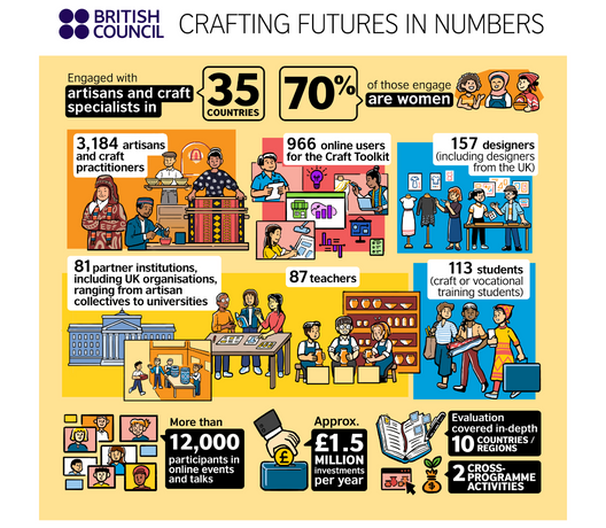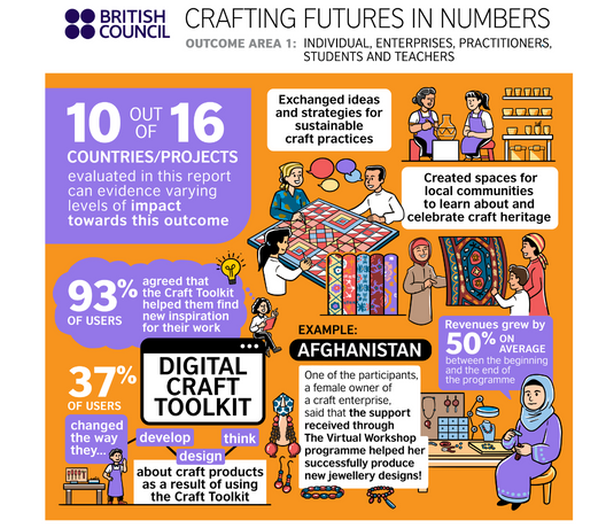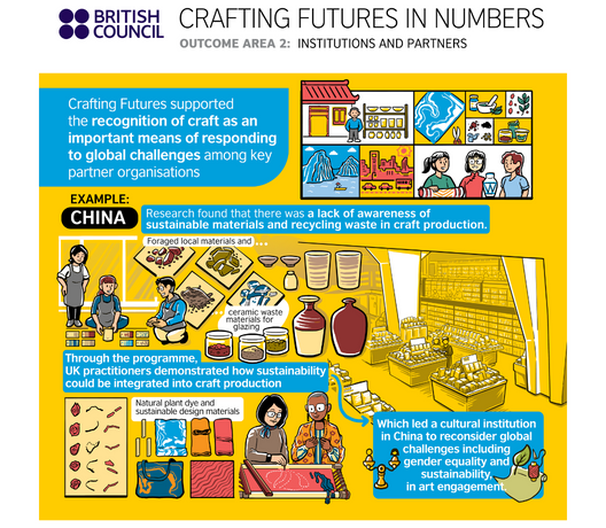2 September 2022
by Sevra Davis
Key findings and learnings from the British Council’s Crafting Futures programme
As the British Council’s Crafting Futures programme has come to an end, we are delighted to share the final report and evaluation which looks at the impact of Crafting Futures over its duration. Read the final report and evaluation here.
Crafting Futures is a global programme conceived and delivered by the British Council which aims to support a more sustainable future for crafts around the world and ensure that craft is appreciated for economic, social and environmental development. The programme first began in 2017 with a few parallel craft-focused programmes and was formally established by the British Council’s Architecture Design and Fashion team in 2019 as a three-year programme running from 2019 through 2022.
Introduction
Crafting Futures brought together craft practitioners, designers and organisations from around the world to explore possibilities for this future together. It provides education and training opportunities, connects artisans from rural communities with international designers, creates international partnerships and increases access to new markets and audiences.
The programme enabled designers and artisans to develop their practices (including with technology), empowers them to create their own businesses, and improve their abilities to shape local craft markets and sell their products locally and internationally. Activities included residencies, hands-on workshops, creation labs, exhibitions, and discussions on design, fashion, entrepreneurship, indigenous knowledge and cross-cultural creation. The programme investigated environmental impacts, resource efficiency, health and safety, intellectual property rights and other key considerations.
Importantly, Crafting Futures was tailored to the needs of the local communities, and its inclusive approach means it is open to craft practitioners of any background in any location.
Since 2019, the programme engaged with artisans and craft specialists in 35 countries and 70% of those engaged were women. The programme successfully supported them to develop their skills and boost their ability to earn more income. In its final year, 2021-22, the programme was active in 20 countries across East Asia, South Asia, Latin America and Wider Europe. The list of country projects presented in the report is a only small selection of projects conducted in the context of Crafting Futures.
Impact and Evaluation
The British Council commissioned The Social Investment Consultancy (TSIC) to conduct a global evaluation of the Crafting Futures programme. The evaluation report summarises the impact of Crafting Futures, based on the programme’s Theory of Change focused on four areas:
- Individual, enterprises, practitioners, students and teachers
- Institutions and partners
- System Change
- International Collaborations
More information and detail on these areas of impact can be found in the report. In brief, however, over the three years, the Crafting Futures programme reached:
- 3,184 artisans and craft practitioners
- 35 countries, including seven communities in Thailand
- 966 online users for the Craft Toolkit
- 113 students (craft or vocational training students)
- 157 designers, including designers from the UK
- 87 teachers
- 81 partner institutions, including UK organisations, ranging from artisan collectives to universities
- More than 12,000 participants in online events and talks
Next Steps and Acknowledgements
While the three-year programme has ended, we are delighted that Crafting Futures will live on in through the work of the craftspeople around the world who have received grants and developed their practice through collaboration as well as through the evolving Craft Toolkit. We very much hope that the toolkit will continue to be a useful resource for craftspeople who developing businesses to help with business goals, overall business planning, creating design concepts, developing products, sales and marketing, as well as budget management. Artists, designers, entrepreneurs or anyone else interested in crafts can freely access the Craft Toolkit online.
In addition, we hope there will continue to be opportunities for craftspeople and crafts organisations to further the British Council’s crafts work in countries around the world – watch this space!
Finally, it is important to acknowledge the contributions of those who worked so hard to design and deliver the Crafting Futures programme over the years: British Council colleagues Kendall Robbins, Katia Stewart, and Caroline Meaby, as well as the British Council Arts teams in all the countries involved in Crafting Futures delivery. In addition, there are countless craftspeople, artisans and crafts support organisations in the UK and around the world without whom the programme would not have succeeded. We would also like to thank Bonnie Chiu, Auréliane Fröhlich and Yu-Shan at The Social Investment Consultancy for their research into the evaluation and authorship of the final report.
Our thanks to everyone who has been involved in the programme over the years for their support of Crafting Futures.
Category
British Council Project
Location
UK
Tags
Craft
Crafting Futures
Creative Industries
Culture
Grant
Research




